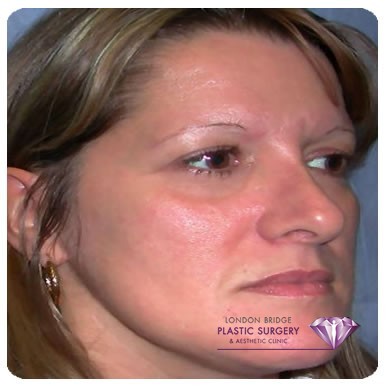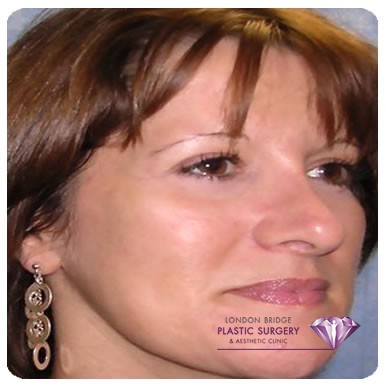In your first discussion with a practitioner, you should explain what you expect from the treatment and how you would like to look afterwards. He or she should tell you exactly what the treatment will involve, and discuss any potential complications and the recovery process following any procedure. He should make it clear that he can achieve the results that you desire.
You will need to discuss the advantages and disadvantages of the different types of malarplasty surgery and implant material used. If you choose a synthetic implant, you would normally require a skin test before surgery to ensure that you are not allergic to the material.
A medical history should be taken by the practitioner to make sure that there are no reasons why you shouldn’t have a facial implant. Once this is established, you would normally be asked to read detailed information and sign a consent form, which means that you have understood the potential benefits and risks associated with the procedure.
Photographs may also be taken by the practitioner for use as a “before and after” comparison at a later date.
Anaesthesia
Local anaesthetic injections along with a mild sedative to make you feel drowsy may be used. Alternatively, a full general anaesthetic may be used, depending upon the area treated and implant material used.
As with any surgical procedure, the use of a general anaesthetic carries a small additional risk which your practitioner will discuss with you. No form of anaesthetic will be given to you without your surgeon discussing it with you first.
The procedure
The procedure is usually performed in an outpatient surgical centre, either run separately by your surgeon, or in a hospital. The operation takes between 30 minutes to 2 hours depending on the extent of the procedure and the implant material used.
Procedures vary depending upon the surgeon and implant material used, but as a guide you may expect the following…
Cheek implants
This involves placing the implant over the cheekbone through a cut made inside the mouth or through an opening just beneath the lower eyelash. The incision blends with the lash line and is nearly unnoticeable. The surgeon creates a pocket in the tissue and then places the implant in there.
Malar implants are inserted in the outer upper cheek area giving that high cheekbone look of many models.
Submalar implants are inserted in the lower or mid-cheek region to help fill out a sunken face. The face seems to become thinner as we age and many people seek this kind of implant to return their faces to a more youthful look. In fact, a more natural appearance can be achieved with fat transfer because this recreates the “rounder” look to your face by using your own fat from somewhere else in your body.
Some patients choose to have a combination of both malar and submalar implants to plump out both the cheekbones and main cheek areas.
In some cases, depending on the type of implant material used, a small titanium screw may be used to attach the implant to the bone. Incisions used are closed with stitches that dissolve in a week or two.
Chin implants
Incisions are usually made inside the mouth on either side of the lower lip. However, depending on the structure of your face, some surgeons may use an incision point directly under the chin which will leave a small scar.
The surgeon creates a pocket into which the lower-jaw implant can be placed. Cuts under the skin are closed with dissolving stitches, and incisions on the outside of the skin are usually stitched with removable stitches.
Implants for lines/wrinkles
This procedure is usually done using a local, rather than a general, anaesthetic and takes around 30 minutes or so.
The most common area of use is for nasolabial folds (the lines between the corners of the nose and the mouth).
Small incisions are usually placed either side of the line, and the implant material is threaded through the skin beneath the fold to help to plump out the line. The tiny incisions are then stitched together.
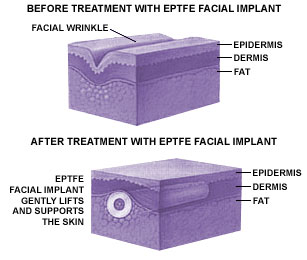
Repeat procedure
No repeat procedure is required for synthetic implants as their effect is permanent, but if you choose to use a non-permanent implant material, you may need to return occasionally to have another implant put in.


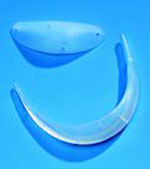 The first synthetic (or man-made) implants that avoided this problem were designed in the 1950s and were made of solid silicone. These implants are safe, long lasting, and are still a popular choice used by many surgeons today.
The first synthetic (or man-made) implants that avoided this problem were designed in the 1950s and were made of solid silicone. These implants are safe, long lasting, and are still a popular choice used by many surgeons today.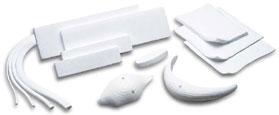 It is a white "rubbery" material - the same thing used in Gore-Tex™ boots and rain jackets - but of course it is totally sterile and made specifically for medical use only.
It is a white "rubbery" material - the same thing used in Gore-Tex™ boots and rain jackets - but of course it is totally sterile and made specifically for medical use only.
